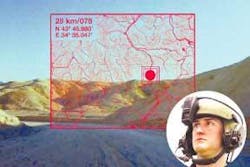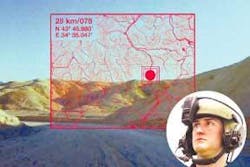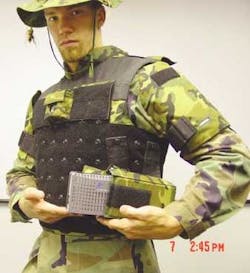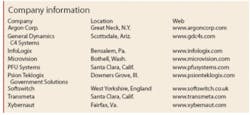Wired and ready to wear
Military systems designers are adapting and fielding wearable computers perfected in the commercial world for defense personnel worldwide.
Commercial inventions such as the Apple Computer iPod or personal data assistants (PDA) are the most well-known forms of wearable computers; everyone uses them, from grocery clerks to CEOs. The U.S. Armed Forces are adopting wearable computers rapidly as well, but their devices will tend to be more rugged than commercial wearables, and their missions more critical than just scheduling meetings or doing inventory.
Wearable computers - devices that are attached or integrated into an individual’s clothing - are considered to be the electronic heart of the soldier of the future.
Military applications for wearable computers in the past typically included maintenance electronics and medical devices to help experts quickly diagnose equipment malfunctions and soldiers’ wounds in the field.
Now, thanks to state-of-art technology and inventive minds in industry and government laboratories, engineers are developing computers that are wired into clothing and have the capability to track enemy targets, network the soldier with air, land, and sea forces, monitor his physical health, and even translate native languages. Devices are also in production that will aid law enforcement and military personnel in the global war on terrorism.
Wearable trends are moving away from “one size fits all” toward a scalable family of products with common architecture, but sized depending on the role and mission, according to Chris Marzilli, a vice president and deputy general manager for General Dynamics C4 Systems (GD C4S) in Scottsdale, Ariz. For example, an infantry soldier may only require voice communication and position reporting, whereas a company or battalion commander may require display of friend/foe location and more complete operational messaging.
Other trends include embedded tactical communication modems for interoperability, with a gamut of VHF, UHF, and satellite radios, Marzilli says. Also playing important roles in wearable computing, according to Marzilli, are secure precise Global Positioning Systems, advanced chemistry batteries and future fuel cells, body networks configurable to introduce new devices seamlessly as they become available.
Of equal importance are low-power sunlight-readable displays for night-vision goggles, detachable flexible displays based on organic light-emitting- diode (OLED) technology, head-up displays, and open-interface connectivity to advanced weapons and sensors, Marzilli says.
GD C4S is the prime contractor for the U.S. Army’s Land Warrior program and as part of that system is developing an advanced soldier ensemble with a true wearable computer interfaced on a USB 2.0 “personal area network” with body hub, Marzilli says.
The company also is the prime contractor for the Common Hardware Software program, for which engineers are developing the Commander’s Digital Assistant, with PDA and tablet variants that provide squad and platoon-level leaders with a situational- awareness display up to full SGA resolution in a 6.5-inch diagonal screen, embedded tactical modem, secure GPS, and 1.1-GHz M processor running any of Windows, Solaris, or Linux operating systems.
Land Warrior integrates everything the foot soldier wears and carries into a close-combat fighting system that enhances his situational awareness, lethality, and survivability.
The wearable computer will offer situational awareness to the infantry soldier that will help separate friend from foe. The driving forces behind these computers are commercial companies, which are taking advantage of a fast-growing market.
Market potential
Tim Shea, senior analyst at Venture Development Corp. in Natick, Mass., says the wearable-computer market should grow to about $560 million worldwide by 2008 with government/military/homeland security applications taking up about $74 million, if the Army’s Land Warrior system is fielded by then.
“Government/military usage is primarily spread across battlefield, logistics, and vehicle/aircraft maintenance applications,” Shea says. “We’re also starting to see small transactions for wearables among first responders and other homeland security areas starting to grow.”
Companies leading the way with products for the military include Microvision in Bothell Wash., Xybernaut in Fairfax, Va., General Dynamics C4 Systems, Argon Corp. in Great Neck, N.Y., and InfoLogix in Bensalem, Pa.
Microvision
In a company white paper, “Out the Hatch Situational Awareness,” Microvision officials describe how their wearable computer, Nomad, improves situational awareness for commanders in the field.
Situational awareness, the paper points out, drives the need for electronic information on opposing forces, neutrals and noncombatants, terrain maps, spot reports and messages, vehicle sensors such as driver vision enhancement and gunner displays, and “the time-tested human vision of the surrounding tactical environment.”
“With situational awareness armor units can confidently and swiftly take the fight to the enemy while avoiding friendly fire incidents,’’ according to the Microvision report. “Today’s challenge is to provide the Tank Commander/Vehicle Commander and the unit leader with tactical area situational awareness.”
The Nomad helmet-mounted display enables the commander to keep his head outside the vehicle while also accessing vehicle displays. It provides electronic information that is visible under all lighting conditions and enables the commander/ leader to remain aware of his situation without ducking into the vehicle.
One hundred Nomad helmet-mounted display systems have been deployed in Iraq, Microvision officials say. “Feedback from the field has been overwhelmingly positive with comments like - the only problem with the Nomad is that we don’t have enough of them,” according to the company white paper. “For the 3-20 Brigade, the Nomad Helmet Mounted Display consisted of a display module attached to the helmet, a video control module mounted to the vehicle, with a cable connected to the FBCB2 [Force XXI Battle Command, Brigade-and-Below] computer system. For the 1-25 Brigade the system has been upgraded to provide the ability to switch between the FBCB2, thermal weapon display, and thermal driver’s display with head-out-of-the-hatch operation. Nomad is a see-through, daylight readable display repeater in both applications.”
“There is close correlation between the rapid deployment/rapid engagement operational requirements of the Stryker brigade and the need of the Stryker commander to monitor tactical digital information while maintaining visual contact with the battlefield,” says Andrew Lee, Microvision’s vice president of sales. “The Nomad Augmented Vision System provides a high-contrast, daylight-readable, see-through display of battlefield information, enabling the commander to continuously view outside situations as they develop.”
The Stryker Brigade Combat Team (SBCT) is designed to bridge the gap between the Army’s light and heavy armored forces. The units provide combat commanders increased operational and tactical flexibility. An eight-wheeled medium weight armored vehicle, it is the SBCT’s primary combat and combat support platform.
Xybernaut
Xybernaut, one of the fastest-growing wearable computer companies, has devices in all branches of U.S. Military.
One of their most recent wins is to deploy wireless Xybernaut Atigo T/HB, “high bright” mobile/wearable computers for U.S. Army Apache attack helicopter maintenance at Fort Campbell, Ky. These machines, which are tailored to support personnel who work most often in outdoor sunlight, are to support the Army’s automated logbook application that helps maintain Apache helicopters. This technology is to reduce “off aircraft” maintenance time and increase real time maintenance awareness.
Companies and field-maintenance technicians for mission-critical equipment need a tool that minimizes the need for experts to travel to remove service and repair locations, can cut repair/service costs, and make repairs easier and more efficient, Xybernaut officials say.
The devices provide field technicians with a comfortable and powerful mobile computer integrated with a portable satellite communications unit, Xybernaut officials say. It enables technicians in the field to access experts wirelessly from any location. The ability to work remotely through live video feeds and data sharing minimizes the amount of down time of the equipment being repaired, company officials claim.
Xybernaut’s latest wearable product integrated with a garment collar received U.S. Patent 6,798,391, “Wearable Computer System.” The system has a wearable computer with its components movably located in a collar (which the user wears around his or her neck. The computer components can be a display, monitor, a microphone, or audio headset.
The computer components can extend beyond the confines of the collar and are adjustable - such as to be moved near the user’s face. When the components are not in use, they can retract back inside the collar for convenience and protection, company officials say.
“For the war fighter and first responder the ability to gain access to computing and communication capabilities in a hands- free manner is essential.” For the field service technician, the mechanic, and many others it is simply the most efficient way they can possibly to their jobs,” says Steven A. Newman, president and chief operating officer of Xybernaut.
General Dynamics
Officials at General Dynamics C4 Systems are providing the U.S. Air Force with 10 prototype tablet computers powered by direct liquid-fuel cells for evaluation as a potential replacement for the service’s current ground air-traffic-control computers.
The program will combine commercial off-the-shelf computer equipment with privately developed fuel-cell technology, and could enable extended field operations that would reduce the Air Force’s reliance on centrally located recharging apparatus and spare batteries, General Dynamics officials say.
As a subcontractor to SRA International Inc. of Fairfax, Va., on the program, General Dynamics is responsible for overall systems engineering, program management, and subcontract management, and will deliver 10 prototype GoBook tablet computers from Itronix in Spokane, Wash., and five prototype fuel-cell power packs and associated refueling cartridges.
Medis Technologies Ltd. in New York will supply the fuel-cell systems, which have previously been demonstrated to operate portable electronic devices. Officials of the Air Force Research Lab at Wright Patterson Air Force Base, Ohio, will test the system in the field.
“This science and technology initiative will equip the U.S. Air Force with an enhanced Battlefield Air Operations kit, including an advanced computing platform with increased endurance for dismounted missions in an overall lighter, wearable and more deployable package,” Marzilli says. “The prototype also could have implications for multiple Department of Defense instruments and applications, including, among other candidate products, powering the Joint Tactical Radio System (JTRS) Cluster 5 family of handheld and embedded software-defined radios.
“The first instantiation is an adapted industrial rugged tablet computer and its ‘wearability’ is limited to a hand/wrist strap and a soldier portable carrying case,” Marzilli continues. “The next generation will incorporate an entire ensemble and be more ‘body worn.’ GD C4S developed the complete requirements and design specification for the tablet and fuel-cell run-time extender in consult with the respective OEMs. The hardware item designs were the responsibility of Medis for the fuel cell and Itronix for the tablet PC. The first deliveries will be with a 1.6-GHz Pentium-M CPU module.”
Project results are to be released in a final report about 13 months after the project’s start. The project also will evaluate potential modifications to the Itronix GoBook that would enable compatibility with night-vision goggles, enable increased daylight readability, enable the computer to boot in “stealth” mode without audio or video detection, operate with a passive touch screen, and other enhancements, GD C4S officials say.
Argon
Combat systems designers at International Technologies Lasers Ltd. (ITLasers) in Rishon-Le-Zion, Israel, are using a rugged wearable computer from Argon Corp. in Great Neck, N.Y.
Designed to fit in a pocket, the Argon Wearable PC weighs 1.25 pounds, has an 800-MHz x86-compatible processor, and runs Windows or Linux applications. It has a solid-state flash hard drive as large as three gigabytes, built-in 10/100 baseT Ethernet, optional modem, and capability to connect external devices over RS422/485, RS232, and USB ports.
InfoLogix
The Via II-CT wearable computers from Infologix in Bensalem, Pa., are used in applications for the U.S. Army, McDonalds, Frito-Lay, and Northwest Airlines.
The II-CT weighs 1.6 pounds and offers hands-free use in a variety of functions. Features include 128 megabytes of DDR SDRAM memory (as much as 256 megabytes of DDR), a 6.4-gigabyte hard drive (or more), and two Type II PCMCIA card slots. The InfoLogix II-CT PC runs either Windows 2000 or XP.
The body-worn computer makes it possible for mobile users to record and track information with the power of a full-function desktop - all in the form of a wearable PC, InfoLogix officials say.
The device’s Crusoe processor provides customers with the ability to choose the amount of processing power best suited to their application. The functionality of the wearable can be expanded by adding peripherals such as handheld displays, wireless LANs, GPS, cellular phone, and video cameras. The II-CT 667 uses the Transmeta Crusoe 5600 running at 667‑MHz and the II-CT 1G uses the Transmeta Crusoe 5800 running at 1 GHz.
The computer’s lithium-ion batteries last for as much as six hours and are hot-swappable.United Kingdom company makes fabrics interactive
Engineers at Softswitch in West Yorkshire, England, have developed a way to make fabrics touch-sensitive and interactive.
Examples are a roll-up QWERTY keyboard, a jacket that interfaces with a mobile phone, a television remote control sewn into the arm of a sofa, or light switches embedded in curtains and carpets, Softswitch officials say.
Softswitch is a technology developed to enable textiles to function as interfaces to control any type of electronic device. Essentially, this means that soft flexible fabrics can be used in place of conventional hard switches, keypads, keyboards, buttons, or knobs, company officials say. Softswitch fabrics can be used for proportional control or pressure sensing and can interface directly with any type of electronic device without the need for signal processing or complex software, Softswitch officials claim.
From wearable audio and computing to mobile phones and personal healthcare, Softswitch enables the portability and softening of traditionally large hard-plastic devices. The technology also enables clothing to interact remotely with electronic devices.
One of the first applications to use Softswitch is the Burton Amp, a snowboarding jacket made exclusively for use with iPod, Apple’s portable digital music player. Softswitch technology allows the iPod to be controlled through a soft, flexible, textile control pad integrated directly in the arm of the Amp jacket. Riders simply touch the control pad on the jacket sleeve to change songs or volume levels, while the iPod is held safely in the jacket’s chest pocket. As the Softswitch keypad is a textile solution it enables the Burton Amp Jacket to be machine washable - when the iPod is removed, Softswitch officials say.
Microvision develops virtual-cockpit helmet-mounted display for Army
Officials at Microvision in Bothell, Wash., recently announced that the company has received a contract modification for an additional $3.85 million for virtual-cockpit helmet-mounted displays from the U.S. Army Product Manager, Air Warrior, awarded through the U.S. Army’s Aviation Applied Technology Directorate (AATD), located at Fort Eustis, Va.
The one-year contract is for advanced miniaturization and ruggedization development of Microvision’s Scanned Beam display technology, which the Army is supporting for potential use in attack and utility helicopters under a pilot navigation flight system, called the Virtual Cockpit Optimization Program (VCOP). Microvision’s display technology is well suited for use in the Army’s proposed navigation system due to its potential for providing variable lighting conditions (readable in bright sunlight to dim night operations) and full color, and the expected cost efficiencies associated with a small, light-weight display device that draws very low power, Microvision officials say.
The navigational and terrain overlays that appear on the helmet display depict Force XXI Battle Command, Brigade-and-Below (FBCB2) information critical to mission effectiveness, and have previously been flight tested with positive results, Microvision officials say. This contract also incorporates development work for the modification of the Electronic Data Manager (EDM, a knee-board style touch-screen display) software and hardware for integration into the VCOP system. Microvision officials say that the virtual-cockpit concept and its variations can be used not only to provide digital information (see-through/color) in older analog helicopters, but will also support a variety of other military aircraft, military ground vehicles, and eventually infantry soldiers.
“The VCOP program provides both technical and cost advantages to the Army,” says Rob Sainsbury, general manager of government programs for Microvision. “Aging helicopter cockpits present a real problem. Legacy analog avionics can be cumbersome to upgrade, particularly as new digital capabilities become available. Maintaining or upgrading cockpit hardware requires re-engineering, replacement, and re-wiring. This expensive procedure removes the aircraft from service for an extended period. The VCOP helmet-mounted display, however, is small, lightweight and can readily upgrade legacy cockpits with digitized information without extensive cockpit refurbishment. We believe the flexible, cost-effective VCOP system will help the Army deploy and maintain the most advanced helicopter cockpits available while offering substantial savings compared to the cost of upgrading all the instruments, software, and supporting elements in an existing helicopter’s avionics suite.”



